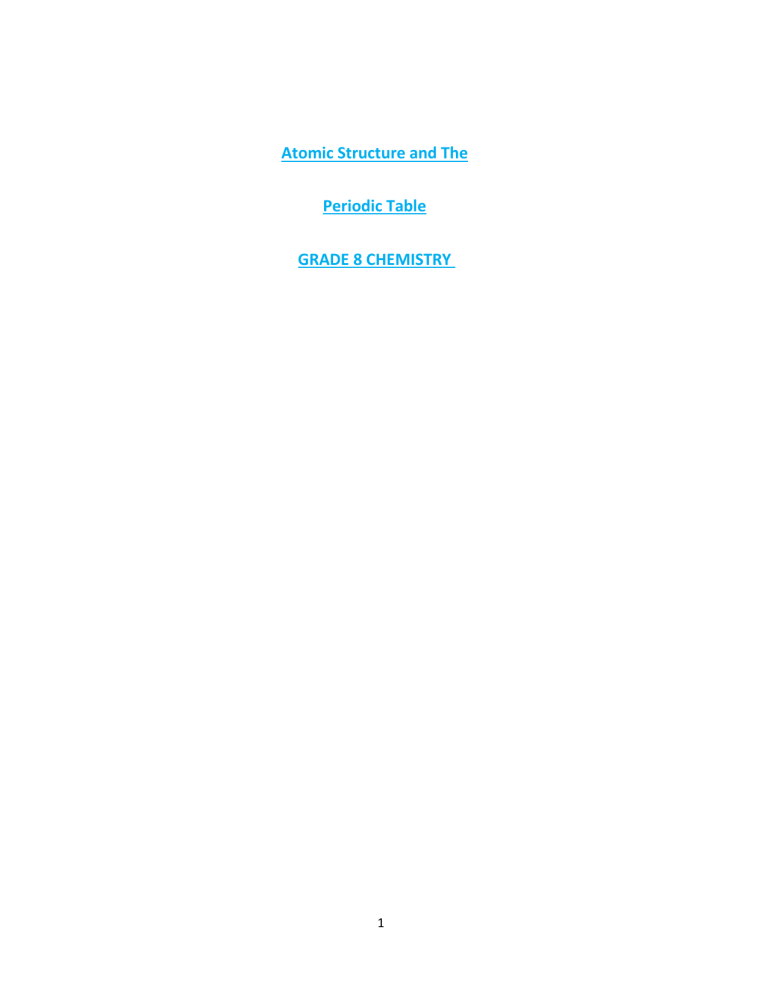Grade 8 Chemistry Worksheet: Atomic Structure & Periodic Table
advertisement

Atomic Structure and The Periodic Table GRADE 8 CHEMISTRY 1 1 The table gives the composition of three particles. particle number of protons number of electrons number of neutrons A 15 16 B 15 16 C 15 17 (a) What is the evidence in the table for each of the following? (i) Particle A is an atom. [1] (ii) A, B and C are all particles of the same element. [1] (iii) Particles A and C are isotopes of the same element. [2] (b) (i) What is the electronic structure of particle A? [1] (ii) Is element A, a metal or a non-metal? Give a reason for your choice. [1] 2 2 Protons, neutrons and electrons are subatomic particles. (a) Complete the table to show the relative mass and relative charge of a proton, a neutron and an electron. particle relative mass relative charge proton neutron 1 1840 electron [3] (b) Bromine has two isotopes. (i) Define the term isotope. ............................................................................................................................................. ....................................................................................................................................... [2] (ii) Explain why the two isotopes of bromine have the same chemical properties. ............................................................................................................................................. ....................................................................................................................................... [2] (c) The table shows the number of protons, neutrons and electrons in some atoms and ions. Complete the table. particle 7 3 number of protons number of neutrons number of electrons 19 22 18 Li 34 216 S [5] 3 3 (a) (i) De ine the term atomic number. ....................................................................................................................................... [1] (ii) Define the term nucleon number. ............................................................................................................................................. ....................................................................................................................................... [2] (b) The table shows the number of protons, neutrons and electrons in some atoms or ions. Complete the table. The first line is given as an example. particle number of protons number of electrons number of neutrons symbol or formula A 6 6 6 12 6C B 12 12 12 C 8 D 11 16 2- 8O 10 13 [6] 4 4 (a) The table below gives information about particles. Complete the table. The first line has been done for you. particle number of protons number of electrons electronic configuration charge on particle A 12 10 2,8 2+ 18 2,8,8 1– 2,8,8 0 B C 18 D 8 10 [4] (b) Gallium is a Group III element. Define the term element. .................................................................................................................................................... .................................................................................................................................................... .............................................................................................................................................. [1] (c) The following are gallium atoms. 69 Ga 71 Ga 31 31 Complete the following table. atom number of protons number of neutrons number of electrons 69Ga 31 71 Ga 31 [3] 5 5 (a) The symbols of six particles are shown below. Na+ Ca2+ Kr P Si O2– Select from the list of particles to answer the following questions. A particle may be selected once, more than once or not at all. (i) Which two ions have the same electronic structure? ................................................... [1] (ii) Which ion has the same electronic structure as an atom of argon? ............................. [1] (iii) Which atom can form an ion of the type X3–? ............................................................... [1] (iv) Which atom can form a hydride which has a formula of the type XH4? ........................ [1] (b) (i) How many protons, neutrons and electrons are there in one copper(II) ion number of protons 64 29 Cu2+ ? ..................... number of neutrons ..................... number of electrons ..................... [2] (ii) 45 21 Sc represents an atom of scandium. How many nucleons and how many charged particles are there in one atom of scandium? number of nucleons ..................... number of charged particles ..................... [2] 6 ©Two different atoms of sodium are (i) 23 11𝑁𝑎 and 24 11𝑁𝑎 Explain why these two atoms are isotopes. ............................................................................................................................................. ....................................................................................................................................... [2] (ii) 24 Na11is radioactive. It changes into an atom of a different element which has one more proton. Identify this element. ....................................................................................................................................... [1] (iii) State two uses of radioactive isotopes. ............................................................................................................................................. ....................................................................................................................................... [2] 6 Complete the following table which gives the number of protons, electrons and neutrons in each of the five particles. particle .............. number of protons number of electrons number of neutrons 19 19 20 .............. .............. .............. 3 2 .............. .............. .............. 34 36 45 56 26 Fe .............. 70 31 Ga 3+ .............. [Total: 8] (a)Define the termisotope. .................................................................................................................................................... .............................................................................................................................................. [2] (b) The table gives information about four particles, A, B, C and D. Complete the table. The first line has been done for you. 7 particle number of protons number of electrons A 6 6 B 11 10 C 8 D number of neutrons nucleon number symbol or formula 12 C 12 O2– 8 10 28 Al 3+ [7] 8 2 The table below gives the composition of six particles which are either atoms or ions. particle number of protons number of neutrons number of electrons A 33 40 33 B 19 20 18 C 34 45 36 D 33 42 33 E 13 14 13 F 24 28 21 (a) Which particles are atoms? Explain your choice. .................................................................................................................................................... .............................................................................................................................................. [2] (b) Which particle is a negative ion and why has this particle got a negative charge? .................................................................................................................................................... .............................................................................................................................................. [2] (c) Which particles are positive ions? .............................................................................................................................................. [1] (d) Explain why particle A and particle D are isotopes. .................................................................................................................................................... .............................................................................................................................................. [2] [Total: 7] 9 10



